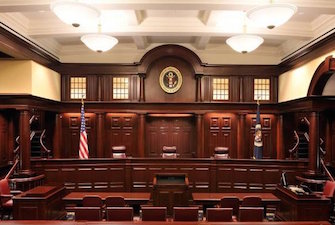For co-pending and related proceedings before the Board, arguments must be fully made in filings. Incorporation by reference violates the Board’s rules and can result in an inability to raise such arguments on appeal.
 Recently, the Federal Circuit affirmed a decision of the Patent Trial and Appeal Board, holding that the Board correctly determined that the claims 21–24 of U.S. Patent No. 6,754,640 (’640 patent) and claims 1-20 of U.S. Patent 8,768,840 (’840 patent), both owned by Bozeman Financial LLC (Bozeman), are directed to patent ineligible subject matter under 35 U.S.C. § 101. To reach this decision, the Federal Circuit first determined the appellees, all 12 of the United States Federal Reserve Banks (Banks), to be “persons” under the America Invents Act (AIA) and, therefore, eligible to petition for post-issuance review under the AIA. See Bozeman Fin. LLC v. Federal Reserve Bank of Atlanta, No. 2019-1018, 2020 U.S. App. LEXIS 11315 (Fed. Cir. April 10, 2020) (Before Lourie, Dyk, and Moore, Circuit Judges) (Opinion for the Court, Moore, Circuit Judge).
Recently, the Federal Circuit affirmed a decision of the Patent Trial and Appeal Board, holding that the Board correctly determined that the claims 21–24 of U.S. Patent No. 6,754,640 (’640 patent) and claims 1-20 of U.S. Patent 8,768,840 (’840 patent), both owned by Bozeman Financial LLC (Bozeman), are directed to patent ineligible subject matter under 35 U.S.C. § 101. To reach this decision, the Federal Circuit first determined the appellees, all 12 of the United States Federal Reserve Banks (Banks), to be “persons” under the America Invents Act (AIA) and, therefore, eligible to petition for post-issuance review under the AIA. See Bozeman Fin. LLC v. Federal Reserve Bank of Atlanta, No. 2019-1018, 2020 U.S. App. LEXIS 11315 (Fed. Cir. April 10, 2020) (Before Lourie, Dyk, and Moore, Circuit Judges) (Opinion for the Court, Moore, Circuit Judge).
The Federal Circuit first addressed the issue of standing for the Banks. Bozeman argued in a supplemental brief that “the Banks are not ‘persons’ under the AIA, and therefore they may not petition for post-issuance review under the AIA.” Bozeman’s position was based on the fact that the Banks are government entities as defined by the Supreme Court of the United States in Return Mail, Inc. v. U.S. Postal Service, and that such designation, according to the Supreme Court, makes them not “persons.” See Return Mail, Inc. v. U.S. Postal Service, 139 S.Ct. 1853 (2018). The Banks, in response, argued that (1) Bozeman waived their argument by not raising it to the Board and (2) that the Banks are distinct from the United States Government, thus distinguishing from the Return Mail decision.
In addressing the issue of personhood of the Banks, the Federal Circuit first determined that because the issue was a purely legal inquiry (e.g., statutory interpretation) relating to patent law, it was appropriate for the Federal Circuit to exercise its discretion to reach the issue. The Federal Circuit then proceeded to distinguish the Banks from the Postal Service, which was at issue in Return Mail. In doing so, the Federal Circuit pointed to the fact that “the Banks’ enabling statute does not establish them as part of an executive agency, but rather each bank is a ‘body corporate.’” See Bozeman, citing to 12 U.S.C. §341. The Federal Circuit further pointed out that the Banks “do not receive congressional appropriated funds,” that “no Bank official is appointed by the President,” and that “Banks cannot promulgate regulations with the force of law” in reaching its conclusion that Banks are “persons” under the AIA, and are thus eligible to put forward post-issuance petitions.
The Federal Circuit then turned to the issue of patent eligibility under 35 U.S.C. § 101 by reviewing the patents. The ’640 and ’840 patents are entitled “Universal positive pay match, authentication, authorization, settlement and clearing system.” The ’840 patent is a continuation of the ’640 patent. The patents relate to “methods for authorizing and clearing financial transactions to detect and prevent fraud.” See ’640 and ’840 patents at Abstract. During the post-issuance review of the ’640 patent, the Board determined (1) that the claims of the ’640 patent were directed to the abstract idea of “collecting, displaying, and analyzing information to reconcile check information against a ledge” and (2) that the claims of the ’640 patent lacked an inventive concept make them nevertheless eligible. Similarly, during the post-issuance review of the ’840 patent, the Board determined (1) that the claims of the ’840 patent were directed to the abstract idea of “collecting and analyzing information for financial transaction fraud or error detection” and (2) that the claims of the ’840 patent lacked an inventive concept make them nevertheless eligible. Bozeman appealed these decisions on the basis that claimed methods are “physical process[es] that improve handling and processing of checks”; therefore, they are not directed towards abstract ideas.
The Federal Circuit addressed the patent eligibility of the claims of the ’640 and ’840 patents by applying the two-step framework set forth by the Supreme Court in the Alice decision. In its analysis, the Federal Circuit used claim 1 of the ’840 patent, which recites “receiving…a first record of an electronic financial transaction,” “storing… said first record,” “receiving… a second record of an electronic financial transaction,” and comparing the records to determine a match before authorizing the transaction. The Federal Circuit found that Bozeman was limited to the arguments made regarding the ’840 patent claims because, in the proceeding before the Board regarding the ’640 patent, Bozeman attempted to argue that “the ’640 Patent would fall under the same Section 101 Patentability as the child parent, the ’840.” The Federal Circuit found that this limited the arguments regarding eligibility of the ’640 patent to those made in the ’840 proceeding. Accordingly, the Federal Circuit needed only address the eligibility rationale from the ’840 proceeding.
At step one of the Alice test, the Federal Circuit agreed with the Board and concluded that claim 1 was directed to the abstract idea of “collecting and analyzing information for financial transaction fraud or error detection.” In reaching this conclusion, the Federal Circuit compared the claims to those found to be ineligible in Solutran, Inc. v. Elavon, Inc. and Credit Acceptance Corp. v. Westlake Servs. See Credit Acceptance Corp. v. Westlake Servs., 859 F.3d 1044, 1054–56 (Fed. Cir. 2017); Solutran, Inc. v. Elavon, Inc., 31 F.3d 1161 (Fed. Cir. 2019). Further, the Federal Circuit found that though Bozeman argued that the “claimed method is a physical process that improves handling and processing of checks, not an abstract idea,” the claims of the ’840 patent did “not… limit the method to steps to processing a physical check.”
After finding, at step one, that claim 1 of the ’840 patent was directed to an abstract idea, the Federal Circuit continued to step two of the Alice test, or the “inventive concept” step. Here, the Federal Circuit looked to the ’840 patent’s specification. The Federal Circuit found that “[t]he specification further demonstrates that the technological components recited in claim 1 of the ’840 patent were conventional, off-the-shelf computer components” and that “the use of a digital-image scanner to create a digital electronic record of a check… does not meet the machine-or-transformation test.” Accordingly, the Federal Circuit found that no inventive concept existed in the claim and affirmed the Board’s decision regarding the patent eligibility of the claims of the ’840 patent. The Federal Circuit then reiterated that Bozeman had not preserved any eligibility arguments regarding the ’640 patent separate from the ’840 arguments, and consequently they are ineligible for similar reasons.
Accordingly, the Federal Circuit affirmed the district court’s decision.

![[IPWatchdog Logo]](https://ipwatchdog.com/wp-content/themes/IPWatchdog%20-%202023/assets/images/temp/logo-small@2x.png)



![[Advertisement]](https://ipwatchdog.com/wp-content/uploads/2024/04/UnitedLex-May-2-2024-sidebar-700x500-1.jpg)
![[Advertisement]](https://ipwatchdog.com/wp-content/uploads/2024/04/Artificial-Intelligence-2024-REPLAY-sidebar-700x500-corrected.jpg)
![[Advertisement]](https://ipwatchdog.com/wp-content/uploads/2024/04/Patent-Litigation-Masters-2024-sidebar-700x500-1.jpg)

![[Advertisement]](https://ipwatchdog.com/wp-content/uploads/2021/12/WEBINAR-336-x-280-px.png)
![[Advertisement]](https://ipwatchdog.com/wp-content/uploads/2021/12/2021-Patent-Practice-on-Demand-recorded-Feb-2021-336-x-280.jpg)
![[Advertisement]](https://ipwatchdog.com/wp-content/uploads/2021/12/Ad-4-The-Invent-Patent-System™.png)






Join the Discussion
3 comments so far.
Bemused
May 4, 2020 10:08 amPro Say@2: Bozeman was robbed.
If anyone is interested in reading about the Federal Reserve Bank’s war against William Bozeman, search for the Washington Times article entitled “At War with the Fed: Independent Inventor’s Story Akin to ‘David vs. Goliath'”
Pro Say
May 3, 2020 05:48 pm. . . and yet another ends-justifies-the-means decision.
Bozeman was robbed.
“See no evil, hear no evil, . . . restore no innovation.”
— Congress
Anon
May 2, 2020 03:10 pmThe 101 aspect is far more troubling than the juristic person aspect.